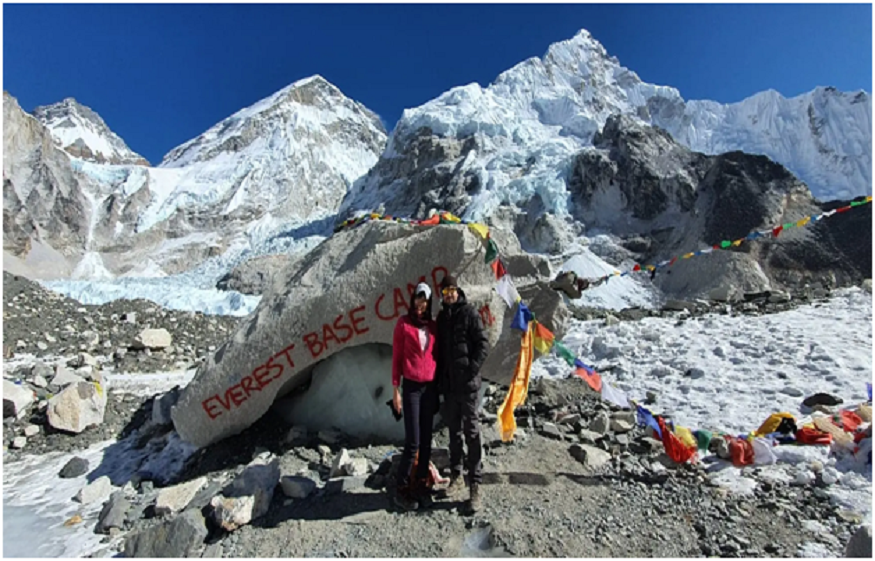
The towering peaks of the Himalayas, covered in snow and mystifications, have charmed explorers for periods.. Among them lies an amazing path—a combination of tough excellence, crude challenge, and otherworldly arousal. Titled suitably as “A trek Over the Clouds,” this travel fastens together three of the most notorious enterprises in Nepal: the Everest Base Camp trek, the requesting climb of Island peak, and the magnificent crossing of the Cho La Pass. It’s not just a trek—it’s a high-altitude trek into the heart of the world’s tallest mountains.
Everest Base Camp trek: Into the Lap of Legends
Every extraordinary enterprise starts with a dream, and for most, that dream begins with the Everest Base Camp trek. Considered one of the world’s most noteworthy trekking courses, this amazing path leads climbers through antiquated Sherpa towns, quiet rhododendron timberlands, and underneath the look of mammoths like Lhotse, Nuptse, Ama Dablam, and Everest itself.
The towering peaks of the Himalayas, covered in snow and mystifications, have charmed explorers for periods.As elevation rises, the discussion diminishes, but the soul reinforces. Pedestrians discover themselves tromping over the tree line, encompassed by ice wastes and moraine denes . Arriving at Everest Base Camp( 5,364 m) is a dreamlike hassle — a rough outcrop settled next to the Khumbu Icefall, where rovers get ready for their peak thrust. A fair day’s rise from then lies Kala Patthar( 5,545 m) — the climaxing edge point for all- encompassing views of Everest flashing brilliantly in the daylight.
The Everest Base Camp trek isn’t fair in approximately coming to a goal. It’s about strolling the strides of legends, breathing the tenuous discourse of history, and finding one’s versatility in the midst of the mightiest mountains.
Island peak Climbing: Overcoming the Himalayan Sky
While Everest Base Camp tests continuance, Island peak Climbing requests specialized ability, mettle, and assurance. Known locally as Imja Tse, this 6,189- cadence peak stands altitudinous among the frigid monsters, advertising to hankering mountain rovers the chance to taste genuine Himalayan climbing.
From Chhukung, the path separates from the standard touring course and starts a more extreme rise.. The Island peak base camp sits encompassed by icy masses, rugged edges, and quiet, as it were, that the mountains can offer. After acclimatization and planning—which incorporates learning rope strategies, ice hatchet care, and crampon utilization—the summit offered starts in the early hours, frequently around midnight.
Climbers rise up steep scree slants, cross glaciated territory, and handle a 100-meter headwall of ice some time recently, the last edge to the summit. The remuneration? A 360-degree display of the world’s most radiant peaks—Lhotse, Makalu, Baruntse, Ama Dablam, and indeed far-off Kanchenjunga. The feeling of standing on Island Peak’s summit is indefinable—a blend of fatigue, triumph, and sheer awe.
What makes Island peak so uncommon is its openness for amateur climbers combined with its honest-to-goodness mountaineering involvement. It’s more than just a fair peak—it’s a custom of section, a passage into the domain of high-altitude climbing.
Cho La Pass trek: The Wild, Blustery Intersection of the Khumbu
Connecting the Everest locale with the Gokyo Valley is the compelling Cho La Pass (5,420 m)—a sensational, glaciated crossing that includes both enterprise and amazement forHimalayan travel. More than a fair section, the Cho La is a test of will, coarseness, and spirit.
The path to the pass leads through the stark excellence of Dzongla and Thagnak. It’s a scene change—the green of the lower valleys supplanted with blue cold lakes, dark shake faces, and unending snowfields. Trekkers rise some time recently at daybreak to start the rising, exploring boulders, frosty slants, and ridgelines carved by centuries of wind and time.
Reaching the best of Cho La Pass trek is a minute solidified in memory. The cold wind cuts through layers, but the scene—flanked by Cholatse, Lobuche, and the Gokyo peaks—is nothing short of enchanted. Underneath lies the way to the turquoise lakes of Gokyo, the towering Ngozumpa Ice Sheet, and the summit of Gokyo Ri—another idealized perspective of Everest and beyond.
The Cho La Pass isn’t just a physical crossing—it’s a typical one. It bridges treks, scenes, and encounters, advertising one of the most changed and fulfilling trekking combinations in the Himalayas.
A Total Himalayan Symphony
What makes “A trek Over the Clouds” special is not just the entirety of its parts, but how they weave together into an exceptional Himalayan orchestra. From the well-trodden ways of the Everest Base Camp to the vertical test of Island peak and the windswept saddle of Cho La, this course offers everything: social inundation, otherworldly profundity, physical challenge, and unrivaled mountain beauty.
This trek challenges you—rationally and physically. You’ll feel the burn in your legs, the chill in your lungs, and the hush in your soul. But more critically, you’ll feel lively. You’ll make companionships over campfires, discover peace in isolation, and return with stories that live long after the travel ends.
Tips for the trek
Training Things: Particularly for Island peak and Cho La Pass, perseverance and quality preparation will pay off. Get ready with cardio, climbs, and essential climbing skills.
Acclimatize Well: The course covers extraordinary heights. Take rest days, hydrate, and tune in to your body.
Gear Up Right: From quality boots and layers to climbing equipment for Island peak, pack carefully.
Travel with a trusted direct: nearby guides not, as it were, guarantee security but improve the encounter with stories, conventions, and master knowledge.
Respect the mountains: they are magnificent but unforgiving. Regarding the environment, culture, and weather.
Conclusion: Over and Beyond
“A trek Over the Clouds” is more than just a fair trip—it’s a change. It’s approximately going higher than you thought conceivable, pushing boundaries, and finding that the genuine summit lies inside. Whether you’re observing dawn over Everest, holding your ice hatchet on Island peak, or catching your breath on Cho La Pass, you’ll get it: a few ways are strolled not fair with the feet, but with the heart.
In conclusion, when the path blurs behind you and the mountains have become a memory, what remains is the altar inside—the clarity, the boldness, and the calm update that once, you strolled over the clouds.

